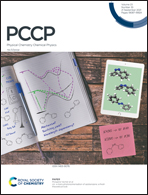The role of high-density and low-density amorphous ice on biomolecules at cryogenic temperatures: a case study with polyalanine†
Abstract
Experimental techniques, such as cryo-electron microscopy, require biological samples to be recovered at cryogenic temperatures (T ≈ 100 K) with water being in an amorphous ice state. However, (bulk) water can exist in two amorphous ices at P < 1 GPa, low-density amorphous (LDA) ice at low pressures and high-density amorphous ice (HDA) at high pressures; HDA is ≈20–25% denser than LDA. While fast/plunge cooling at 1 bar brings the sample into LDA, high-pressure cooling (HPC), at sufficiently high pressure, produces HDA. HDA can also be produced by isothermal compression of LDA at cryogenic temperatures. Here, we perform classical molecular dynamics simulations to study the effects of LDA, HDA, and the LDA–HDA transformation on the structure and hydration of a small peptide, polyalanine. We follow thermodynamic paths corresponding to (i) fast/plunge cooling at 1 bar, (ii) HPC at P = 400 MPa, and (iii) compression/decompression cycles at T = 80 K. While process (i) produced LDA in the system, path (iii) produces HDA. Interestingly, the amorphous ice produced in process (ii) is an intermediate amorphous ice (IA) with properties that fall in-between those of LDA and HDA. Remarkably, the structural changes in polyalanine are negligible at all conditions studied (0–2000 MPa, 80–300 K) even when water changes among the low and high-density liquid states as well as the amorphous solids LDA, IA, and HDA. The similarities and differences in the hydration of polyalanine vitrified in LDA, IA, and HDA are described. Since the studied thermodynamic paths are suitable for the cryopreservation of biomolecules, we also study the structure and hydration of polyalanine along isobaric and isochoric heating paths, which can be followed experimentally for the recovery of cryopreserved samples. Upon heating, the structure of polyalanine remains practically unchanged. We conclude with a brief discussion of the practical advantages of (a) using HDA and IA as a cryoprotectant environment (as opposed to LDA), and (b) the use of isochoric heating as a recovery process (as opposed to isobaric heating).

- This article is part of the themed collection: 2021 PCCP HOT Articles


 Please wait while we load your content...
Please wait while we load your content...
